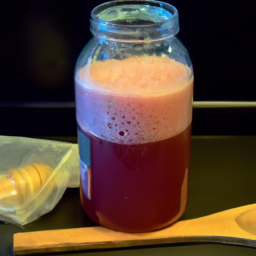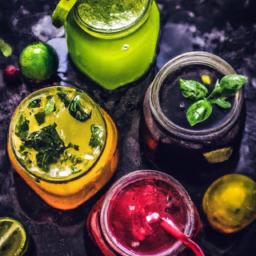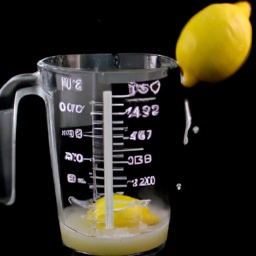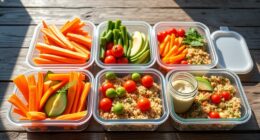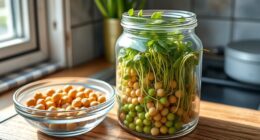The act of fermentation transforms basic juice into a tasty and beneficial beverage, piquing the interest of numerous individuals. As a passionate home brewer, I have explored the fermentation of various fruits and vegetables and can attest to the many benefits that this traditional technique offers.
Fermented juice is not only packed with probiotics and enzymes that support gut health and digestion, but it can also be a refreshing and flavorful alternative to sugary sodas and juices.
In this article, I will guide you through the process of fermenting juice step by step, from selecting the right equipment to trying out delicious recipes. Whether you are a seasoned fermenter or a curious beginner, you will learn everything you need to know to create your own fermented juice at home.
So let’s get started and explore the fascinating world of juice fermentation!
Key Takeaways
- The fermentation process converts sugars into alcohol, carbon dioxide, and other compounds, which improves taste, shelf life, and health benefits of the juice.
- Proper maintenance and cleaning of equipment and materials, temperature control and monitoring, and starter culture are necessary for successful fermentation.
- Choosing high-quality, fresh juice without additives or preservatives, experimenting with flavor pairings, and straining the juice to remove pulp or seeds are important steps in making fermented juice.
- Regular consumption of fermented juice is recommended, as it is packed with probiotics that improve gut health and boost the immune system. Safe fermentation practices are crucial for optimal results.
Understanding the Fermentation Process
Now that you’ve got your juice ready, let’s talk about how you can turn it into a delicious fermented drink!
Fermentation is a scientific process that converts sugars into alcohol, carbon dioxide, and other compounds. It is a natural process that can happen spontaneously, but controlling the conditions of fermentation can improve the taste, shelf life, and health benefits of the final product.
Fermentation benefits are not limited to creating an alcoholic beverage. Fermented drinks have been shown to have numerous health benefits, including improved digestion, increased immune function, and reduced inflammation.
The science behind fermentation involves microorganisms, such as yeast or bacteria, breaking down the sugars in the juice and producing alcohol and other compounds. The type of microorganism used, as well as the temperature and time of fermentation, can greatly affect the final taste and composition of the drink.
Now, let’s move on to the next step of choosing the right equipment for your fermentation process.
Choosing the Right Equipment
When selecting the appropriate gear, it’s important to consider the size of your batch and the length of time you plan to ferment. For smaller batches, a simple mason jar with a lid or airlock can suffice. However, for larger batches, a fermenting crock or stainless steel container may be necessary.
It’s also important to consider the material of the container, as certain metals can react with the acidic nature of the juice and affect the taste.
In addition to selecting the appropriate gear, it’s important to maintain and clean your equipment properly. This includes regularly sanitizing your containers, airlocks, and any other equipment used in the fermentation process.
Cost-effective options for equipment can include repurposed containers, such as glass jars or plastic buckets, or purchasing second-hand equipment. By properly maintaining your equipment and selecting the right gear for your batch, you can ensure a successful fermentation process.
As you move into the next section about selecting the right juice, it’s important to remember the impact that equipment and maintenance can have on the final product.
Selecting the Right Juice
To make the most delicious and flavorful fermented drink, you’ll want to choose a high-quality, fresh fruit or vegetable that you love. When selecting juice for fermentation, keep in mind the following tips:
-
Choose juice that is free of additives or preservatives, as these can inhibit the fermentation process.
-
Opt for juice that is not pasteurized, as this process kills off any natural yeasts present in the juice.
-
Consider using a mix of juices to create a unique flavor profile.
-
Experiment with different flavor pairings to find your perfect combination.
By carefully selecting your juice, you can create a drink that is both tasty and healthy. Once you’ve chosen your juice, it’s time to move onto preparing it for fermentation.
Preparing the Juice
Get the best flavor out of your selected fruit or vegetable by thoroughly cleaning it before squeezing the juice. This is an essential step in the juice fermentation process. If you use dirty or contaminated produce, your juice can spoil quickly, ruining all your hard work.
The best way to clean your produce is by rinsing it under cold water and scrubbing it gently with a soft brush. This removes any dirt, bacteria, or chemicals that may be on the surface.
Next, you need to prepare your juice for fermentation. Depending on the type of juice you’re using, you may need to blend different fruits and vegetables to get the right flavor profile. For example, if you’re making a green juice, you may want to blend kale, spinach, cucumber, and celery to create a balanced flavor. If you’re making a fruit juice, you may want to blend sweet fruits like apples, pears, and grapes with tart fruits like lemons or limes to create a delicious flavor combination.
Once you’ve blended your juice, make sure to strain it to remove any pulp or seeds. This will ensure that your fermentation process goes smoothly and that you end up with a clear, tasty drink.
Now that your juice is prepared, it’s time to add a starter culture to begin the fermentation process.
Adding a Starter Culture
As I introduce a starter culture into the juice, it’s like planting a seed that will bloom into a flavorful and fizzy drink.
There are various types of starter cultures that can be used to ferment juice, but the most popular ones are kefir grains, kombucha SCOBY, and wild yeasts. Kefir grains are lactic acid bacteria and yeast that create a thick and tangy drink. Kombucha SCOBY, on the other hand, is a symbiotic colony of bacteria and yeast that produces a slightly sour and effervescent beverage. Meanwhile, wild yeasts are naturally occurring microorganisms that can be found in the air, on fruits, and even on our skin. They can be unpredictable but can also yield unique and complex flavors.
One crucial factor in fermenting juice with a starter culture is temperature control. The ideal temperature range for most starter cultures is between 68-78°F (20-25°C). If the temperature is too low, the fermentation process may take longer, and the drink may not be as carbonated. On the other hand, if the temperature is too high, the bacteria and yeast may produce off-flavors or even die. It’s essential to monitor the temperature regularly, especially during the first few days of fermentation, when the microorganisms are most active.
As we move on to fermenting the juice, we need to shift our focus from introducing the starter culture to monitoring the fermentation process.
Fermenting the Juice
Now that we’ve added a starter culture to our juice, it’s time to move on to the next step: fermenting the juice.
Juice fermentation is a process that involves the natural breakdown of sugars in the juice by microorganisms, resulting in the production of alcohol, lactic acid, and carbon dioxide. This process not only improves the flavor of the juice but also increases its nutritional value.
One of the benefits of juice fermentation is that it can enhance the digestibility and bioavailability of nutrients in the juice. Fermentation breaks down complex carbohydrates and proteins, making them easier for the body to absorb. Additionally, fermented juice contains beneficial bacteria known as probiotics that can improve gut health and boost the immune system.
However, it’s essential to be careful during the fermentation process to avoid common mistakes that could lead to spoilage or contamination. The fermentation process can be unpredictable, and there are some common mistakes to avoid, such as using contaminated equipment, not properly sterilizing jars or bottles, or fermenting at the wrong temperature.
By following proper guidelines and being careful during the fermentation process, we can ensure that our juice turns out delicious and safe to consume.
As we move on to the next section about monitoring the fermentation process, it’s crucial to keep in mind that fermentation is an ongoing process that requires attention and care. By monitoring the progress of fermentation, we can ensure that our juice is fermenting correctly and avoid any potential issues that could arise during the process.
Monitoring the Fermentation Process
Keeping an eye on how our mixture is progressing is important during the fermentation process to ensure a delicious and safe end product. To monitor the fermentation process, we need to measure the acidity of the juice regularly. The acidity level will change during fermentation, and it’s essential to keep track of these changes to ensure that the juice doesn’t become too acidic or too sweet. We can use a pH meter or pH strips to measure the acidity level of the juice.
Ideally, we want the acidity to be between 3.5 and 4.5 pH. If the acidity level is too high, we can add calcium carbonate to reduce it. If the acidity level is too low, we can add more sugar to increase it.
Another critical aspect of monitoring the fermentation process is adjusting the sweetness of the juice. As the yeast consumes the sugar, the juice will become less sweet. However, we don’t want the juice to become too dry, as it will affect the taste of the final product.
To adjust the sweetness, we can add more sugar to the juice. It’s important to add the sugar in small amounts and to test the sweetness regularly. We can use a refractometer to measure the sugar level of the juice.
Once the acidity and sweetness levels are optimal, we can proceed to the next step of storing and aging the fermented juice.
Storing and Aging Fermented Juice
Once we’ve achieved the optimal acidity and sweetness levels, it’s time to store and age our deliciously fermented beverage. Long term storage is essential to further develop the flavor of our juice. This process may take weeks or even months, depending on the desired taste. We can store our fermented juice in glass bottles or jars, making sure to leave some headspace to allow for carbonation. It’s important to keep the bottles or jars in a cool, dark place to prevent any further fermentation.
During the aging process, the flavor of our fermented juice will continue to develop. In fact, we can even create different flavor profiles by experimenting with different storage methods. I’ve found that using oak or other wood barrels can add a unique depth of flavor to the juice. To further emphasize the importance of long term storage, here’s a table to show the effects of aging on flavor development:
| Time Stored | Flavor Development |
|---|---|
| 1 week | Mildly tangy |
| 1 month | Tangy and slightly sweet |
| 3 months | Tart and fruity |
| 6 months | Complex and full-bodied |
Now that we’ve covered the storage and aging of our fermented juice, we can move on to trying out delicious fermented juice recipes.
Trying Out Delicious Fermented Juice Recipes
Who wouldn’t want to dive into some lip-smacking fermented beverage recipes that’ll make your taste buds dance?
Here are some flavor combinations to try out:
-
Classic Apple Ginger: Mix apple juice with freshly grated ginger and add some honey for sweetness. Let it ferment for 2-3 days and enjoy a zesty, refreshing drink.
-
Blueberry Lemonade: Combine blueberry juice with lemon juice and a pinch of salt. Let it ferment for 1-2 days and serve over ice for a tangy and fruity twist on traditional lemonade.
When it comes to serving suggestions, you can get creative and experiment with different garnishes like fresh herbs, sliced fruits, or even edible flowers.
These fermented juice recipes are not only delicious but also good for your gut health.
So, let’s move on to the next section and learn about the health benefits of fermented juice.
Enjoying the Health Benefits of Fermented Juice
To fully reap the health benefits of fermented juice, you should consume it regularly. Fermented juice is packed with probiotics, which are live microorganisms that provide numerous health benefits. These include improving gut health, boosting the immune system, and even reducing the risk of certain diseases. Probiotics work by restoring the natural balance of bacteria in the gut, which is essential for overall health and wellbeing.
Exploring flavor combinations is also a fun way to enjoy the health benefits of fermented juice. Some popular flavors include ginger, turmeric, and citrus fruits like lemons and limes. You can also experiment with different fruits and herbs to create your own unique flavor combinations. Just be sure to use fresh, high-quality ingredients and follow safe fermentation practices to ensure the best results. With the right ingredients and techniques, you can enjoy the delicious taste and health benefits of fermented juice in no time.
Frequently Asked Questions
Can you ferment juice without a starter culture?
Why use a starter culture when fermenting juice? While it can provide consistency, experimenting with different juice blends can lead to unique flavors and beneficial bacteria. However, without a starter culture, there is a higher risk of spoilage and inconsistent results.
How long does it take for juice to ferment?
Fermentation time for juice varies based on factors such as fermentation temperature, sugar content, and presence of yeast or bacteria. Generally, it takes 1-2 weeks for juice to ferment, but this can be longer or shorter depending on these variables.
Can you ferment juice in a plastic container?
Fermenting juice in a plastic container is doable, but glass containers have advantages. They’re more durable and don’t leach chemicals. For successful fermentation in plastic, sanitize it first and keep it in a cool place.
Is it necessary to use organic juice for fermentation?
Using organic juice for fermentation offers the benefits of higher nutrient content and absence of harmful pesticides. Alternatives include non-organic juice, but may contain fewer nutrients and chemicals. Consider using organic for optimal results.
Can you use frozen juice for fermentation?
Yes, frozen juice can be used for fermentation. While fresh juice may produce slightly better results, freezing preserves nutrients and extends shelf life. Benefits of freezing include easier storage and availability.
Conclusion
In conclusion, fermenting juice is a simple and rewarding process that can yield delicious and nutritious beverages. It’s important to understand the fermentation process, choose the right equipment, select the right juice, and prepare it properly. Adding a starter culture and monitoring the fermentation process are also crucial steps to ensure successful fermentation.
One interesting statistic to note is that fermented juices have been consumed for thousands of years and are still popular today. In fact, a recent study found that fermented beverages accounted for a significant portion of global beverage sales, with kombucha alone generating over $1 billion in revenue in 2019. This shows the growing popularity and interest in fermented beverages and highlights the potential for experimentation and innovation in the field of fermented juice.
By following the steps outlined in this article and trying out some of the delicious fermented juice recipes provided, you can enjoy the health benefits and unique flavors of fermented juice. From boosting gut health to providing a natural source of probiotics, fermented juice is a great addition to any healthy lifestyle. So, go ahead and give it a try – your taste buds (and gut) will thank you!
Ilana has been a vegan for over 10 years. She originally made the switch for health reasons, but soon found herself becoming more and more passionate about the ethical and environmental implications of a vegan lifestyle. Ilana is the author of The Graceful Kitchen, a blog all about veganism. She loves to cook up delicious and nutritious vegan meals, and share her recipes with others who are interested in leading a cruelty-free life. Ilana is also a strong advocate for using whole foods as the foundation of a healthy diet, and believes that going vegan is one of the best ways to achieve this.
